Finding and encouraging reptiles in woodlands
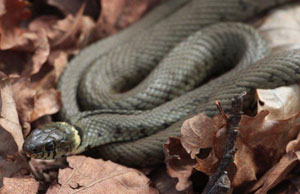
Reptiles and woodland
The first time I came across a Grass Snake in our newly bought wood I almost trod on it, it was a real surprise and I was so lost in my own thoughts it really startled me. I had not thought the woodland provided a very suitable habitat for reptiles and in many respects, it didn’t. Since then I have got a bit more used to seeing a tail disappear at speed into the vegetation and have now started to actively encourage reptiles by improving the habitat for them where I can. Although not everyone’s cup of tea, reptiles are another component of a healthy woodland ecosystem and I have to say, I am a real fan.
The three reptile species you are most likely to find in your wood are the Grass Snake, the Slow Worm and the Viviparous Lizard (more usually called the Common Lizard, poor thing). The Adder, the only venomous British Snake is a possible resident but is more at home in scrubby, heathland type habitat. The other two British species (the Smooth Snake and Sand Lizard) are very rare, highly protected, limited in range and not woodland types.
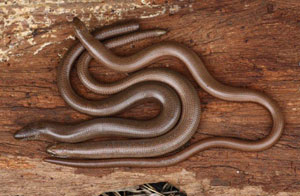
Finding snakes and lizards.
Woodland is not always the best place for reptiles because as ectotherms, they need the warmth of the sun to get them fully active, and dense shaded woodland does not allow enough sunlight through for them to bask. Underneath a dense canopy the ground cover can be very sparse, too. The places that reptiles seek out to inhabit are open sunny glades and rides, with enough dense ground vegetation present to keep them safe from predators and able to find food. Knowing they might be there is one thing but seeing them is another thing altogether as they are very picky about when to show themselves and very easily disturbed.
The best months to look are May, June and September, so this is a good time now. July and August can be too hot for them to spend in the open and they can be harder to see. Overcast and cloudy days are good too, as reptiles need to spend more time catching the sun’s rays, and mornings are often more productive as they need to spend time picking up warmth after cooler nights
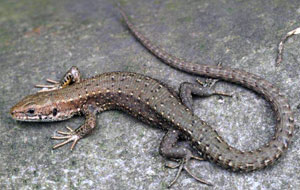 There are essentially two ways to find reptiles. The first is to walk very slowly along suitable habitat, looking about 3 metres ahead (so you spot them before they spot you) focussing on sunny open spots and possible basking places such as brash piles, low logs and open grassy spots. When you walk watch your shadow doesn’t give you away and try to place your feet very quietly. When you get practiced, you begin to know likely spots in your wood and can, with patience, get quite close – Viviparous Lizards and Grass Snakes often stick to the same basking spots if the growing vegetation does not shade them out.
There are essentially two ways to find reptiles. The first is to walk very slowly along suitable habitat, looking about 3 metres ahead (so you spot them before they spot you) focussing on sunny open spots and possible basking places such as brash piles, low logs and open grassy spots. When you walk watch your shadow doesn’t give you away and try to place your feet very quietly. When you get practiced, you begin to know likely spots in your wood and can, with patience, get quite close – Viviparous Lizards and Grass Snakes often stick to the same basking spots if the growing vegetation does not shade them out.
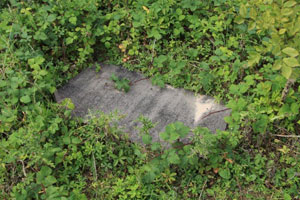 The second technique involves a bit more cunning - you try to encourage the reptiles to come to you by creating inviting basking spots for them in suitable habitat. All sorts of things make good basking places and hideaways – rectangles of roofing felt, bits of corrugated iron, squares of old carpet. I like using rectangles of medium thickness roofing felt as it is not expensive and easy to carry and cut. Left down in sunny open areas, reptiles are fairly quick to use them – Slow Worms don’t like basking in the open so they are very happy to hide under something warm. Grass Snakes often do the same. And so does the occasional Field Mouse. Viviparous Lizards on the other hand like basking on top of these “refuges”(to give them their technical name). Be careful when lifting the refuges to look underneath, use a stick to lift a corner first in the rare chance an Adder is lurking there but more often than not you will find a Slow Worm or Grass Snake underneath. If you do, try not to disturb them, and replace the refuge carefully and promptly. After a couple of years of using refuges I now know which one’s are likely to have a Slow Worm underneath and on which I will see Viviparous Lizards sunning themselves. On a recent visit I found a Grass Snake’s discarded skin under one refuge and a sleepy adult under another – I am pretty certain it’s the same one I have been finding there for a couple of years.
The second technique involves a bit more cunning - you try to encourage the reptiles to come to you by creating inviting basking spots for them in suitable habitat. All sorts of things make good basking places and hideaways – rectangles of roofing felt, bits of corrugated iron, squares of old carpet. I like using rectangles of medium thickness roofing felt as it is not expensive and easy to carry and cut. Left down in sunny open areas, reptiles are fairly quick to use them – Slow Worms don’t like basking in the open so they are very happy to hide under something warm. Grass Snakes often do the same. And so does the occasional Field Mouse. Viviparous Lizards on the other hand like basking on top of these “refuges”(to give them their technical name). Be careful when lifting the refuges to look underneath, use a stick to lift a corner first in the rare chance an Adder is lurking there but more often than not you will find a Slow Worm or Grass Snake underneath. If you do, try not to disturb them, and replace the refuge carefully and promptly. After a couple of years of using refuges I now know which one’s are likely to have a Slow Worm underneath and on which I will see Viviparous Lizards sunning themselves. On a recent visit I found a Grass Snake’s discarded skin under one refuge and a sleepy adult under another – I am pretty certain it’s the same one I have been finding there for a couple of years.
Making your wood reptile friendly
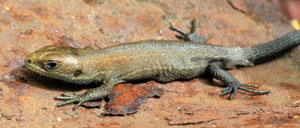 All three common species have similar basic requirements – places to find food, mates and warmth. You can help encourage reptiles by creating open glades and sunny rides, the best one’s run east/west so the sun tracks along them. They need to be wide enough so the sun can reach the lower plants for most of the day. You will probably need to keep the taller shrubby vegetation from shading the ground too much and in my wood I hack down some areas of bracken and bramble so the sun can hit reach the low, denser plants and grasses. These areas also encourage flowers and a rich insect fauna– a win for biodiversity all round. Piles of leafy brash make valuable hibernation spots and basking sites. They are also good, warm and safe places for reptiles to raise families. And lastly, provide low piles of logs or artificial refuges to give them needed basking places and protection from predators.
All three common species have similar basic requirements – places to find food, mates and warmth. You can help encourage reptiles by creating open glades and sunny rides, the best one’s run east/west so the sun tracks along them. They need to be wide enough so the sun can reach the lower plants for most of the day. You will probably need to keep the taller shrubby vegetation from shading the ground too much and in my wood I hack down some areas of bracken and bramble so the sun can hit reach the low, denser plants and grasses. These areas also encourage flowers and a rich insect fauna– a win for biodiversity all round. Piles of leafy brash make valuable hibernation spots and basking sites. They are also good, warm and safe places for reptiles to raise families. And lastly, provide low piles of logs or artificial refuges to give them needed basking places and protection from predators.
All our British reptile species are facing difficult times and show gradual declines, so making habitat improvements in your wood will be a real bonus for them. There are a number of national organisations committed to conserving our reptile species and information about where and when you are seeing them is valuable data, so please pass on information and sightings to your local Wildlife Trust or one of the county based Reptile and Amphibian Groups (where I live in Kent its KRAG at www.kentarg.org). These organisations also run training courses and are good sources of information. You may value the opportunity for more detailed advice about encouraging reptiles in your wood, or to have a fuller survey undertaken over several visits, as a small woodland owner and practising ecologist, this is one of the fee based services I can provide. ( you can contact me via [email protected])
And lastly….a really useful publication to have when you are out looking for reptiles is “ Britain’s Reptiles and Amphibians” by Howard Inns (Wild Guides). Its full of detail on individual species and has lots more on their habits and lifestyles. And if you don’t know your Adder from your Slow Worm this is the place to start finding out. 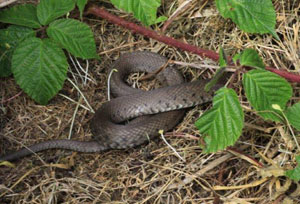 Happy hunting !
Happy hunting !
ps. Sometimes the only view you get – a disappearing snake
Comments are closed for this post.
Discussion
When compared to most other European countries, the UK has relatively few reptiles and amphibians (Indeed, Ireland has no snakes at all, a fact which many people may find pleasing). However, there are a few species which you may find there.
The slow worm and the adder snake are the reptiles one is most likely to encounter in woods but both are extremely secretive and you’d have to be lucky to actually catch sight of either, especially as both species hibernate from October to March.
Do grass snakes bite? cause I am really frightened of any kind of snakes.
That’s good to hear, Rod. It is amazing to watch what happens when the light is allowed in by coppicing. Over time, you will need to think about how best to manage the coppiced areas. The options are to let the coppice grow back or to mainatin it is an open area. I have a variety of approaches and some areas that I keep open specifically for reptiles and butterflies by scything bi-annually and lopping back trees on the border that want the light too.
Can confirm the above article as have ‘ticked all the right boxes’ in our wood with a coppiced area along an east/west ride. Have regularly seen common lizards,with young ones this year on log piles, and on last visit saw two basking grass snakes in different areas. Amazing to see the explosion of new life on a previously dark almost bare ground under overstood coppice.
Another cant to cut this winter so the wildlife will have even more room to spread into, which gives a satisfying feeling to be doing our bit to help.

just found a smooth snake in the forest of dean and do ou know if they are venomous
Nathan
11 May, 2020